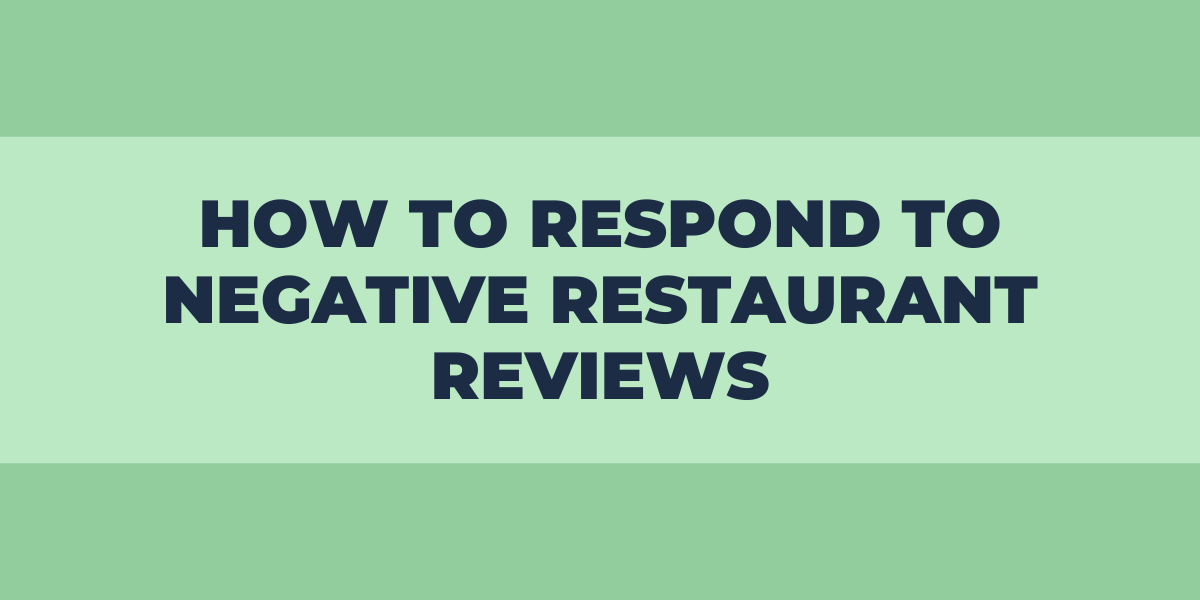Nowadays, restaurants must deal with the reality that customer feedback plays a crucial role in the purchasing process. And let’s be honest, almost every restaurant has, at some point or another, seen a bad review. Your restaurant’s identity and differentiation depend on how you handle those reviews.
If you approach them the right way, you can transform negative reviews into a chance for business that can help your restaurant recover. Stay tuned to find out how to respond to negative restaurant reviews and the best ways to approach them.
Why Is It Important to Respond to Negative Restaurant Reviews?
Negative reviews give you the chance to hear proactive feedback and constructive criticism from the customers who eat at your restaurant. They took the time to leave an online review, even if they might not have wanted to say it in person. That increases your chances of altering their response and obtaining a return client. If they didn’t inform you in person or online, you’ve lost a client you will never win back.
On the other hand, negative feedback should never be ignored because the audience will assume that you don’t care how others see your company. Acknowledging every comment, no matter how brief, demonstrates to them your concern and desire to give them the greatest experience possible.
How to Respond to Bad Restaurant Reviews
To make the consumer feel heard, take the time to emphasize the positive portions of the review by repeating what they say. Express your apology for their negative experience and provide the error’s cause. Customers will see that you value their opinion when you explain why the issue won’t occur again. This tactic is meant to reassure potential clients.
Bad reviews must be addressed politely and professionally.
Examine The Review
This crucial step is sometimes skipped when reacting to unfavorable restaurant reviews. You should thoroughly read the review multiple times. Move gently to ensure that you fully comprehend and absorb the message.
This is not the time for a short read, even if the majority of us scan the Internet. You risk missing the subtly nuanced details that are there. Make notes of the details as you read the review. Here are a few to think about:
- The issue’s creation date.
- Are they furious, irritated, frustrated, or using another tone?
- Do you believe you can fix it?
- The name of the individual and any employees involved
Express Regret for What Occurred
Offer sincere apologies for the bad experience they had. To demonstrate empathy, acknowledge the impact it had on their dining experience. Make sure they understand how much you appreciate their pleasure and how sincerely sorry you are for any inconvenience you may have caused. Showing your guests that you are on their side is crucial.
Respond Timely
Regularly check your Facebook and Google My Business profiles, as well as travel and review sites (Yelp, Tripadvisor, etc.), for fresh reviews. Respond to reviews as soon as possible. Ideally, in a two- to three-day window, placate upset clients before they post a rant about your restaurant.
Responding to bad reviews as quickly as you can demonstrates to your clients that you value their opinions and are dedicated to resolving their issues.
Show Emphaty
Make your guests feel special and important by treating them with the utmost respect. Try to show them that you understand by empathizing with them.
Depending on the situation, your restaurant may or may not be the root of the issue. If you’ve done your study, you’ll probably be able to tell which.
Try to Solve The Issue
Take the appropriate action to resolve the situation, depending on the problem. For instance, if the issue was bad service, speak with the staff members and take into account further training. If the reason for the bad reviews was the cost, the caliber of the food, or the size of the meals, think about giving the customer a discount and making some menu adjustments.
Control Your Emotions
Reading a negative review can be upsetting, especially if it’s about a company you put a lot of effort into starting. Yes, it is crucial to respond timely, but you must think through difficult ones or get a second opinion to see if they’re professional.
Try to understand the reviewer’s perspective and gently address their concerns.
Replying when you’re angry can have consequences. At that moment, you must feel everything is the other person’s fault. But once it’s out there, you will probably regret it.
Look At the Reviewer’s Profile
Do you know the reviewer? Is this a frequent visitor or a newcomer? Can you determine whether a review is valid if it’s anonymous?
Check to see whether this person has a history of leaving unfavorable reviews. Visit their social media profiles. Try to determine if they are locals or visitors.
You can gain insight into your reviewer’s motivations by getting to know them better. For instance, if they leave numerous unfavorable evaluations, you can infer they are hard to please.
Take the Conversation Offline
Ask your customer to take the debate offline and out of the public eye if the problem needs more discussion or settlement. That can help keep things from getting worse and save your internet reputation.
Make sure to provide your email or phone number.
Be Thankful
Maintaining a professional and customer-focused strategy involves thanking your reviewers, even if they have left a negative review. Thank them for taking the time to contribute their thoughts and suggestions. Tell them you appreciate their thoughts and are sensitive to their concerns.
Respond to All Feedback
Responding to all feedback, including positive reviews, can help protect your restaurant’s online reputation. If you respond to only negative ones, people may see it as unnecessary to leave you a good review.
Double-Check Your Response
Remember to double-check for punctuation, grammar, and spelling errors when you respond to a negative review. Submitting a review response with poor grammar and vocabulary will give your restaurant an unprofessional look.
Negative Restaurant Reviews Examples
Now that we know how to respond to negative reviews, let’s take a look at some negative reviews on Yelp and other restaurant review sites and see what good responses for them would be like:
Example #1
Customer: The food was good, but the service was awful. The place was not even full; there were just a couple of other tables occupied, and the waitress didn’t pay attention to us. She was talking on her phone all the time.
Response: Hey (Customer Name)! Thanks for visiting us; we’re glad you enjoyed our food, and we’re sorry you had that terrible experience regarding our service. We do not allow our employees to talk on the phone during the shift unless it’s an emergency. Your server was a new employee, as you might have noticed. We don’t want to treat our consumers with the disregard you experienced, so we will do what it takes for that to never happen again. We’d love to have you back and make it up to you soon.
Thanks for your honest feedback
Regards, (Your Name)—(Restaurant Name)
Example #2
Customer: I ordered the spaghetti carbonara, and it had a strange sour taste. My husband had the Caesar salad, and the dressing also had that taste. We have ordered here before, and this is the first time we have had this issue. We didn’t touch our food, and we paid a lot for it.
Response: Hi (Customer Name)! I’m sorry to hear about your experience with us. Here at (Restaurant Name), we take our food regulation process very seriously. We’ll dig deeper and thoroughly examine what could have happened to prevent it from happening again. Please accept a gift card. We’d love to see you again and serve you the best food in town.
Yours, (Your Name)—(Job Position).
Example #3
Customer: On Sunday, I went to breakfast; there was a little wait for the patio seating. Finally approaching the table, the server just said, “I’m overwhelmed,” We had five people in our gathering, and he delivered two glasses of water. The food was served promptly. It was excellent, but we never received the entrees to enjoy while waiting, never had a drink refilled, and after requesting ketchup, they brought it with the bill. There was a problem with customer service.
Response: Thanks for choosing us, (Customer Name)! We are pleased to learn that you liked the options we offered. We are sorry to hear that our service fell short of your and our expectations.
We’ve been busier than ever since we debuted our breakfast menu, and we are employing more personnel to assist us in providing first-rate service throughout the day. We value your feedback and will give you a discount on your subsequent visits if you call us at (Phone Number).
We would be grateful for the chance to make things right and try to win back your business.
Cheers, the (Restaurant Name) team.
Example #4
Customer: Bad food, awful service. I won’t go back.
Response: Greetings, (Customer Name). We appreciate you taking the time to give our restaurant a review. We apologize if your experience fell short of what you had hoped for.
We regret the problem you encountered and want to reassure you that we are taking action to fix it and enhance the customer experience.
Please contact us personally if you would like to talk about this in more detail. We appreciate all comments and work hard to make sure that everyone who visits our restaurant has a good time. We sincerely appreciate your feedback and hope you give us one more chance in the future.
Sincerely, (Your Name).
Example #5
Customer: I ordered a lasagna, and it seemed microwaved because it was cold inside. Paid too much for it and didn’t get any solution. I don’t recommend this place.
Response: Thank you for letting us know about this, (Customer Name). We regret that your experience was unfavorable. We take pleasure in the quality of our dining experience and work hard to make sure every customer is happy. We sincerely apologize if your most recent visit didn’t meet our expectations. Our manager will contact you personally to give you a refund and a discount coupon for your next visit.
Regards, (Your Name)
FAQs
How Do I Keep Track of My Restaurant’s Online Reviews?
Customers usually go to review networks like Yelp, Google Reviews, and TripAdvisor instead of the main restaurant website, so you or someone from your team must constantly check for new reviews on those websites.
You should also check social networking sites like Facebook, Twitter, TikTok, and Instagram because a lot of people discuss restaurants there. Make sure to keep an eye on the social media accounts for your business and respond to any unfavorable remarks or reviews.
How Do I Avoid Bad Reviews for My Restaurant?
The only way to reduce the risk of negative reviews is to regularly provide a good meal and the finest possible customer service.
Making a strong first impression is important, but so is following it up with excellent customer service every time a client comes in. Although it doesn’t sound easy, there are a few techniques to guarantee that your service is always outstanding:
- Choose the ideal management.
- Give your employees the appropriate training.
- Choose a point-of-sale system that enables you to offer quick, dependable, and personalized service.
What If I Disagree With the Review?
The best thing to do is to reply to negative reviews respectfully and professionally, even if you don’t agree with them. You should also:
- Give your account of the events.
- Thank the client for their comments.
- Say sorry for any problems.
- Ask them to come back and confirm it was a misunderstanding.
Wrapping It Up
Your priority as a restaurant owner is undoubtedly to provide exceptional food, drinks, ambiance, and service. While each is significant, they are not the only factors that contribute to a successful restaurant. It needs a clean and visible online reputation. We hope that our insights and useful examples help you successfully manage your restaurant’s reviews.














